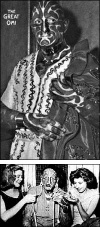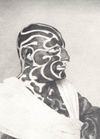Horace Ridler
| Omi | |
|---|---|

| |
| Birth Date | 1892 |
| Birth Place | |
| Death Date | 1969 |
| Occupation | performer |
| Website | none |
Horace Ridler (1892 - 1969), also known as The Great Omi, "Omi the Great", and "The Zebra Man", thanks to his astounding physical transformation.
Biography
The exact details of his story have been somewhat obscured and often exaggerated (intentionally) by Omi and those writing about him. It is generally accepted that he was born into a family that was relatively well-to-do and provided him with great opportunity — including a personal tutor who was allegedly a former circus clown. He is believed to have been well educated and to have received a degree with honors from Oxford or Cambridge. Other accounts have him foregoing university for a military career, but then resigning his commission after the death of his father and squandering his inheritance. In WWI, he enlisted and served with desert mountain corps, was decorated for gallantry, and attained the rank of major. Unable to support himself after the war solely from his pension, he struck upon the idea of becoming a show attraction.
In 1922, Omi began to get tattooed in the usual pictorial (flash) fashion. However, this was decades past the 'golden age' of the tattooed attractions in the mid to late 1800's. Many shows of this time had congresses of tattooed attractions and some even charged them to be part of [...]
Like most tattooed attractions, Omi's act consisted of fanciful tales about his body modification. Stories of abduction in far off countries were common and Omi frequently claimed that he had been captured and tortured via tattooing in New Guinea. While his story was hardly plausible, lack of popular knowledge of far off lands and the unusual design [...]
At the start of WWII, Omi attempted to return to military service but was well beyond service age and was deemed too strange. He spent the war supporting Allied efforts by promoting sales of war bonds. In 1950, Omi retired to Sussex with Omette where they lived quietly until his passing in 1969.
Omi continues to be an inspiration to many tattoo fans and artists today. His images and memorabilia are highly valued and collected around the world.
Selected References
- Freak Show by Robert Bogdan
- "The Great Omi" by Judy Tuttle in Lyle & Judy Tuttle's Tattoo Historian
